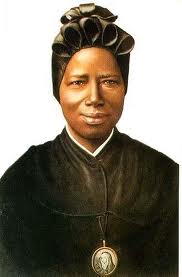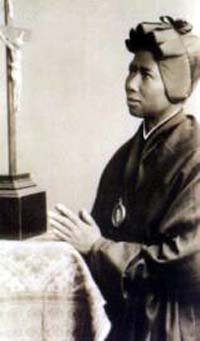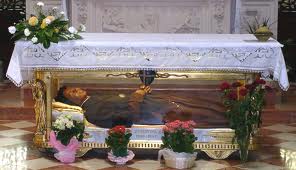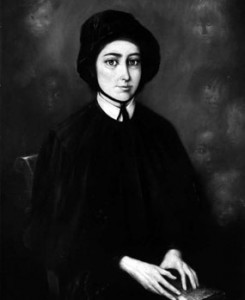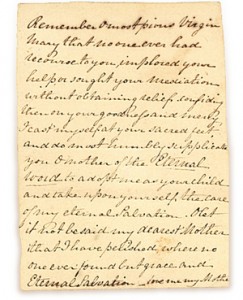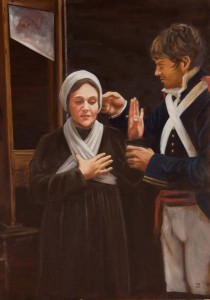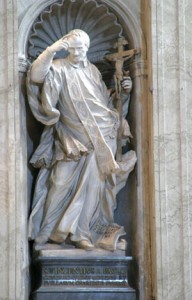One of my very favorite storytellers is Sr. Joan Mueller…give yourself the gift of hearing her share the story of St. 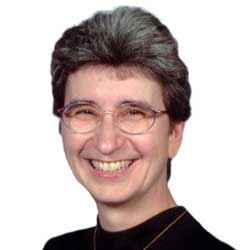 Bakhita in this podcast…
Bakhita in this podcast…
JOSEPHINE BAKHITA (1869-1947)
Mother Josephine Bakhita was born in Sudan in 1869 and died in Schio (Vicenza)Â in 1947.
This African flower, who knew the anguish of kidnapping and slavery, bloomed marvelously in Italy, in response to God’s grace, with the Daughters of Charity.
Mother “Morettaâ€
In Schio (Vicenza), where she spent many years of her life, everyone still calls her “our Black Motherâ€. The process for the cause of Canonization began 12 years after her death and on December 1st, 1978 the Church proclaimed the Decree of the heroic practice of all virtues.
Divine Providence which “cares for the flowers of the fields and the birds of the airâ€, guided the Sudanese slave through innumerable and unspeakable sufferings to human freedom and to the freedom of faith and finally to the consecration of her whole life to God for the coming of his Kingdom.In Slavery
Bakhita was not the name she received from her parents at birth. The fright and the terrible experiences she went through made her forget the name she was given by her parents. Bakhita, which means “fortunateâ€, was the name given to her by her kidnappers.
Sold and resold in the markets of El Obeid and of Khartoum, she experienced the humiliations and sufferings of slavery, both physical and moral.Towards freedom
In the Capital of Sudan, Bakhita was bought by an Italian Consul, Callisto Legnani . For the first time since the day she was kidnappe
d, she realized with pleasant surprise, that no one used the lash when giving her orders; instead, she was treated in a loving and cordial way. In the Consul’s residence, Bakhita experienced peace, warmth and moments of joy, even though veiled by nostalgia for her own family, whom, perhaps, she had lost forever.
Political situations forced the Consul to leave for Italy. Bakhita asked and obtained permission to go with him and with a friend of his, a certain Mr. Augusto Michieli.In Italy
On arrival in Genoa, Mr. Legnani, pressured by the request of Mr. Michieli’s wife, consented to leave Bakhita with them. She followed the new “familyâ€, which settled in Zianigo (near Mirano Veneto). When their daughter Mimmina was born, Bakhita became her babysitter and friend.
The acquisition and management of a big hotel in Suakin, on the Red Sea, forced Mrs. Michieli to move to Suakin to help her husband. Meanwhile, on the advice of their administrator, Illuminato Checchini, Mimmina and Bakhita were entrusted to the Canossian Sisters of the Institute of the Catechumens in Venice. It was there that Bakhita came to know about God whom “she had experienced in her heart without knowing who He was†ever since she was a child. “Seeing the sun, the moon and the stars, I said to myself: Who could be the Master of these beautiful things? And I felt a great desire to see him, to know Him and to pay Him homage…â€Daughter of God
After several months in the catechumenate, Bakhita received the sacraments of Christian initiation and was given the new name, Josephine. It was January 9, 1890. She did not know how to express her joy that day. Her big and expressive eyes sparkled, revealing deep emotions. From then on, she was often seen kissing the baptismal font and saying: “Here, I became a daughter of God!â€
With each new day, she became more aware of who this God was, whom she now knew and loved, who had led her to Him through mysterious ways, holding her by the hand.When Mrs. Michieli returned from Africa to take back her daughter and Bakhita, the latter, with unusual firmness and courage, expressed her desire to remain with the Canossian Sisters and to serve that God who had shown her so many proofs of His love.
The young African, who by then had come of age, enjoyed the freedom of choice which the Italian law ensured.Bakhita remained in the catechumenate where she experienced the call to be a religious, and to give herself to the Lord in the Institute of St. Magdalene of Canossa.
On December 8, 1896 Josephine Bakhita was consecrated forever to God whom she called with the sweet expression “the Master!â€
For another 50 years, this humble Daughter of Charity, a true witness of the love of God, lived in the community in Schio, engaged in various services: cooking, sewing, embroidery and attending to the door.
When she was on duty at the door, she would gently lay her hands on the heads of the children who daily attended the Canossian schools and caress them. Her amiable voice, which had the inflection and rhythm of the music of her country, was pleasing to the little ones, comforting to the poor and suffering and encouraging for those who knocked at the door of the Institute.Witness of love
Her humility, her simplicity and her constant smile won the hearts of all the citizens. Her sisters in the community esteemed her for her inalterable sweet nature, her exquisite goodness and her deep desire to make the Lord known.
“Be good, love the Lord, pray for those who do not know Him. What a great grace it is to know God!â€As she grew older she experienced long, painful years of sickness.
Mother Bakhita continued to witness to faith, goodness and Christian hope. To those who visited her and asked how she was, she would respond with a smile: “As the Master desires.â€Final test
During her agony, she re-lived the terrible days of her slavery and more then once she begged the nurse who assisted her: “Please, loosen the chains… they are heavy!â€
It was Mary Most Holy who freed her from all pain. Her last words were: “Our Lady! Our Lady!â€, and her final smile testifiedto her encounter with the Mother of the Lord.
Mother Bakhita breathed her last on February 8, 1947 at the Canossian Convent, Schio, surrounded by the Sisters. A crowd quickly gathered at the Convent to have a last look at their «Mother Moretta» and to ask for her protection from heaven. The fame of her sanctity has spread to all the continents and many are those who receive graces through her intercession.
Every line of the Collect for Saint Bakhita merits attention; every phrase needs to be repeated in meditation.
O God, who led Saint Josephine Bakhita
from abject slavery
to the dignity of being your daughter and the bride of Christ,
give us, we beseech you, by her example,
to follow after Jesus the Crucified Lord with unremitting love
and, in charity, to persevere in a ready mercy.
Tags: daughters of charity, Jesus, joan mueller, josephine bakhita, love, Mother Bakhita, sr. joan mueller, st. bahkita, st. josephine
This entry was posted on Friday, February 8th, 2013 at 7:21 am
You can follow any responses to this entry through the RSS 2.0 feed.
(The following wonderful reflection on the life of St. Elzabeth Ann Seton is from Fr. Mark Kirby which can be found on his website  Vultus Christi ….I highly encourage you to check it out!!!
which can be found on his website  Vultus Christi ….I highly encourage you to check it out!!!
Dom Mark Daniel Kirby is Prior of the Diocesan Benedictine Monastery of Our Lady of the Cenacle in Tulsa, Oklahoma.His Excellency Bishop Edward J. Slattery of the Roman Catholic Diocese of Tulsa established the monastery in 2009 with the distinctive mission of Eucharistic Adoration for the sanctification of priests.)
William Magee Seton gave this lithograph of Christ the Redeemer to his beloved wife, Elizabeth Ann Seton, sometime between 1774 and 1803. Its Eucharistic theme prophetically reflected the profound devotion to the Most Holy Eucharist that would characterize her piety as a Catholic.
Below is a photograph of a copy of a variant of the Memorare handwritten by Elizabeth Ann Seton. At the end of text she added the touching plea, “Love me, my Mother.
The Italian Experience
The conversion of Elizabeth Ann Bayley Seton began in 1803 while she, a twenty-nine year old widow with one of her five children, were the guests of the Filicchi family in Livorno, or Leghorn, Italy. The Catholic Filicchis, Antonio and his wife Amabilia, offered her a gracious hospitality and unfailing emotional support in a time of crisis.
The Motherhood of the Blessed Virgin
In one of Signora Filicchi’s prayer books, Mrs. Seton came upon the text of Saint Bernard’s Memorare; she found in the Virgin Mary the tenderness and the pity of a mother. “That night,” she writes, “I cried myself to sleep in her heart.”
The Tabernacle
The Filicchi home contained a private chapel where the Blessed Sacrament was reserved. Elizabeth was drawn to the tabernacle. Even before her mind had been instructed in the mysteries of the Catholic faith, her heart recognized the living presence of the Lord in the Most Holy Eucharist. Her American Protestant sensibility was perplexed and, yet, she could not deny her heart’s fascination with the Lamb of God hidden beneath the sacramental veils.
Return to New York
Elizabeth’s long personal memoir, The Italian Journal, recounts the intimate details of her inner struggle and conversion to Catholicism. Elizabeth and her ten year old daughter, Anna Maria, returned to New York on June 3, 1804, accompanied by Antonio Filicchi — a man to whom Elizabeth had become deeply attached. He had become for her a friend and a spiritual counselor. (more…)
Tags: American Catholics, daughters of charity, elizabeth ann seton, fr. mark daniel kirby, Real Presence, spiritual journey
This entry was posted on Friday, January 4th, 2013 at 12:21 am
You can follow any responses to this entry through the RSS 2.0 feed.
Beatification of Sister Marguerite Rutan,
June 19, 2011
From the Daughter of Charity of St. Vincent de Paul website:
“The lives of the saints are not limited to their earthly biographies but also include their being and working in God after death. In the saints one thing becomes clear: those who draw near to God do not withdraw from men, but rather become truly close to them.â€(Deus Caritas est 42).
In February 2011 we published a short article on Sister Marguerite Rutan, Daughter of Charity and martyr (see www.filles-de-la-charite.org/en/news). As her beatification approaches we invite you to learn more about her life. Who is this new example of Vincentian holiness?
A presentation of her life:
Marguerite Rutan was born on 23 April 1736 in Metz in Lorraine and was baptized the same day. Marguerite was the 8th of 15 children. Marie Forat, her mother, was very Christian and her father, Charles Gaspard Rutan was an honest and courageous workman. With them she learned to live her life as a gift from God.
Her father introduced her to mathematics and linear design. Soon she was able to keep the accounts of his business. She helped with all her family until she was 21 years old.
She had the profound conviction she was being called by Jesus. With Him she looked for a way to give herself to the service of those who were poor.
In 1756, Marguerite Rutan entered the Company of the Daughters of Charity to be near those who were suffering, marginalized or excluded. She wanted to serve them. Following Christ she encouraged charity in those around her. For over 20 years she placed everything she received from God and others at the service of the poorest of the poor, no matter where she was sent by her superiors.
In 1779 she was sent to serve in the Hospital of Dax. Sr. Marguerite and her Sisters worked for 10 years relating with the townspeople. The Sisters were admired and respected.
In 1789 the troubling period of the Revolution began. It profoundly changed the country and personally touched Sr. Marguerite with suffering and death (April 9, 1794). Her faithfulness to Christ and the Church lead her to martyrdom. The life of Sr. Marguerite was anchored in the person of Christ and his Word. Each day she profoundly encountered the love of Christ which drew her to serve as He served.
Following Christ, servant of her brothers and sisters, kneeling to wash their feet, Sr. Marguerite gave her life to serve the poor and the sick and building brotherhood with all.
Following Christ, servant of the will of the Father, Sr. Marguerite based her life on the Gospel, desiring only one thing: to do the will of God.
Following Christ, servant of the suffering, despised, persecuted, Sr. Marguerite abandoned herself totoally to God. During the revolutionary turmoil, she showed the extremity of her love.
Interesting links:
Marguerite Rutan: A little history of her life
Tags: Blessed Marguerite Rutan, catholic, catholic podcast, catholic prayer, cathollc spirituality, daughters of charity, france, french revolution, Marguerite Rutan, martyr, martyrdom, Sister Marguerite Rutan
This entry was posted on Thursday, June 21st, 2012 at 1:16 pm
You can follow any responses to this entry through the RSS 2.0 feed.
 The French priest St. Vincent de Paul (1581-1660) organized works of charity, founded hospitals, and started two Roman Catholic religious orders.
The French priest St. Vincent de Paul (1581-1660) organized works of charity, founded hospitals, and started two Roman Catholic religious orders.
Vincent de Paul was born into a peasant family on April 24, 1581, in the village of Pouy in southwestern France. He became a priest at the age of 19, and would go on to found hospitals, charitable organizations and many other ministries and works that would serve the needs of the poor. With Louise de Marillac, a talented and sensitive friend, he started the first religious group of women dedicated entirely to works of charity outside the cloister, a group called the Daughters of Charity.
Vincent was a man of action rather than of theory. The religious spirit he communicated was simple, practical and straightforward. He looked to Christ as his leader and tried to translate the Gospel message into concrete results. He died on Sept. 27, 1660, and was canonized a saint in the Roman Catholic Church in 1737.
Words of Wisdom
from St. Vincent de Paul
“No matter what others say or do, even if the wicked succeed, do not be troubled: commit everything to God and put your trust in him.â€
“The most powerful weapon to conquer the devil is humility. For, as he does not know at all how to employ it, neither does he know how to defend himself from it.”
“But do you know what it is to labor in charity? It is to labor in God, for God is charity, and it is to labor for God purely and entirely; it is to do so in the grace of God.”
A “Great Hero of Charity”
As reported by Zenit, the Holy Father spoke of St. Vincent de Paul:
The Pope reflected on the Gospel reading from today’s Mass, which recounts the story of the rich man suffering torment, and the poor man Lazarus in the bosom of Abraham.The message of the parable, the Holy Father said, “points out that while we are in this world we must listen to the Lord who speaks to us through the Scriptures and live according to his will, because, after death, it will be too late to make amends.”
“So,” he explained, “this parable tells us two things: The first is that [God] loves the poor and lifts them up from their humiliation; the second is that our eternal destiny is
 conditioned by our attitude; it is up to us to follow the road to life that God has shown us, and this is the road of love, not understood as sentiment but as service to others in the charity of Christ.”
The Bishop of Rome called it a “happy coincidence” that Monday marks the feast of one of the Church’s great heroes of charity, St. Vincent de Paul, patron of Catholic charitable organizations.
“In the France of the 1600s, he touched with his own hand the great contrast between the richest and the poorest,” the Pope said. “[…] Driven by the love of Christ, Vincent de Paul knew how to organize stable forms of service to marginalized persons.”
In fact, the saint founded the first women’s congregation to live their consecration “‘in the world,’ in the midst of the people, with the sick and the needy,” he noted.
The Pontiff added, “Dear friends, only Love with a capital ‘L’ makes for true happiness!” – Zenit
Tags: catholic, catholic podcast, catholic prayer, cathollc spirituality, daughters of charity, st vincent de paul
This entry was posted on Tuesday, September 27th, 2011 at 6:52 am
You can follow any responses to this entry through the RSS 2.0 feed.

